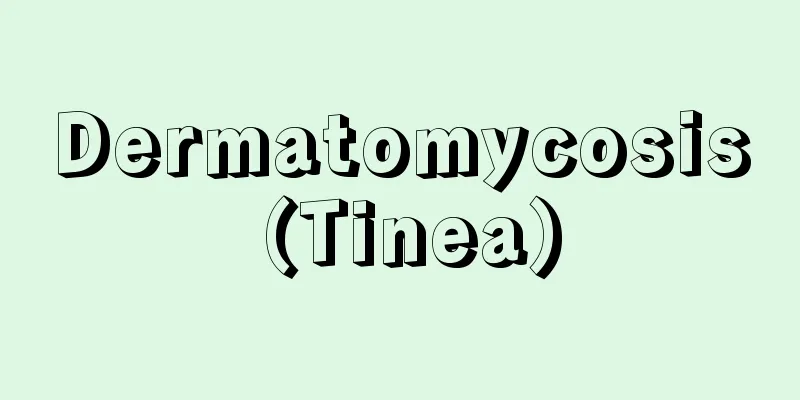Dermatomycosis (Tinea)

What kind of infection is it? A skin disease caused by a fungus (mold) infecting or parasitizing the skin. Ringworm has traditionally been classified into the following types based on its symptoms: - Limited to the epidermis, nails, and hair follicles -Severe inflammation occurs from the dermis to the deeper layers However, in recent years, depending on the site of onset, it has been classified as tinea capitis, tinea facilitia, tinea corporis, tinea cruris, and tinea pedis. Tinea corporis (ringworm) This is superficial tinea that occurs on the body and hands and feet, excluding the head, palms, soles, scrotum, and groin. It is common in people who use topical steroids, and the causative bacteria is It is a relatively strong itchy ring-shaped rash that consists of small blisters (vesicles) and red bumps. Dandruff-like material is attached to the center, and since it looks like the disease has been cured, it is said to have a "central healing tendency." The skin is not as hard or thick as tinea cruris, which will be described later, and the pigmentation is not as strong. Microsporum canis is highly contagious, and small, ring-shaped rashes appear on exposed areas. Tinea cruris (jock itch) Also known as sclerosing tinea, this is a type of superficial tinea that develops on the inside of the thighs (groin area). It is more common in men during the summer, and sometimes occurs in groups. The causative agent is mostly P. rubrum, but in rare cases it can be caused by hairy epidermophyte fungi. It is a ring-shaped eczema-like rash with a clear border that tends to heal from the center, and is very itchy. The skin in the center becomes thick and hard, and pigmentation is seen, and the edge is a ring-shaped arrangement of red papules that merge and form a bank-like protuberance. Tinea pedis (athlete's foot) This is superficial tinea of the feet, and is the most common fungal infection. It mainly occurs in the blister type (hidrotic type) where small blisters form on the soles of the feet, or between the toes. Small vesicle type Small blisters or red papules may appear on the soles or edges of the feet, or the skin may peel and cause severe itching. Interdigital type The skin between the toes peels and becomes white and swollen. It often occurs between the fourth and fifth toes. Hyperkeratotic The keratin over the entire sole of the foot thickens, peels, and cracks appear. - Onychomycosis (athlete's foot on the nail) If tinea pedis is left untreated, the fungus will invade the nails and cause tinea unguium. It was previously thought that tinea pedis rarely developed on the nails, but recent statistics show that half of people with tinea pedis also have tinea unguium. It is more common in the elderly. The main symptoms are thickening and opacity of the nail plate, and there are no subjective symptoms. In rare cases, the only symptom is spot-like or patchy opacity of the nail plate. Testing and diagnosis The most common method is to dissolve the skin, nails, and hair of the dandruff or blisters with potassium hydroxide and observe them under a microscope (KOH method), and sometimes culture them to identify the bacteria. Treatment methodsTopical application of antifungal drugs is common, but oral medication is used for widespread areas, areas that cause rashes from antifungal drugs, and onychomycosis. With topical application, symptoms improve in 4 weeks on the hands and feet, and in 2 weeks on other areas, but topical application is necessary for several months while the skin is replaced. For nail fungus, oral administration is required for at least 3 to 6 months. Mariko Honda Source: Houken “Sixth Edition Family Medicine Encyclopedia” Information about the Sixth Edition Family Medicine Encyclopedia |
どんな感染症か 真菌(カビ)が皮膚に感染、または寄生して起こる病気で、皮膚 白癬は従来、症状から以下のように分類されていました。 ・表皮や爪、毛包に限局する ・真皮から深層に強い炎症症状が起こる しかし近年では、発症部位によって頭部白癬、顔面白癬、体部白癬、股部(こぶ)白癬、 ●体部白癬(ゼニたむし) 体や手足にできる浅在性白癬で、頭部、手のひら、足の裏、陰嚢、陰股部を除く部位の白癬をいいます。ステロイド薬を外用している人に多く、原因菌は 比較的強いかゆみを伴う輪状に配列する発疹で、小さな水ぶくれ(小水疱)、紅いブツブツからなります。中心にはフケ状のものが付着し、病気が治ったようにみえるので、これを“中心治癒傾向がある”と表現します。 後述する股部白癬ほど皮膚が硬く厚くなく、色素沈着も強くありません。イヌ小胞子菌の場合は感染力が強く、露出部に小型の輪状の発疹が多発します。 ●股部白癬(いんきんたむし) 頑癬ともいい、太ももの内側(陰股部)にできる浅在性白癬です。夏季に、男性に多くみられ、時に集団発生することもあります。原因菌は、大部分が猩紅色菌ですが、まれに有毛表皮糸状菌によることもあります。 中心治癒傾向がある境界鮮明な輪状の湿疹様の発疹で、激しいかゆみがあります。中心部の皮膚は厚く硬くなり、色素沈着がみられ、辺縁は紅色丘疹が輪状に配列、融合して、堤防状の隆起を形成します。陰股部、 ●足白癬(水虫) 足にできる浅在性白癬で、最も頻度の高い真菌症です。主に、足底に小水疱ができる小水疱型(汗疱型)、足の指の間にできる 小水疱型 足底や足縁に小水疱や紅色丘疹ができるか、または皮がむけ、強いかゆみがあります。 趾間型 足の指の間の皮がむけ、白くふやけたようになります。親指から4番目の指と5番目の指の間によく発症します。 角質増殖型 足底全体の角質が厚くなり、皮がむけ、あかぎれも生じます。 ●爪白癬(爪の水虫) 足白癬を放置していると、白癬菌が爪を侵し、爪白癬になります。爪にできることはまれと従来いわれていましたが、最近の統計によると足白癬をもつ人の半分が爪白癬ももっていることがわかりました。高齢者に多くみられます。 爪の甲の肥厚と白濁を主な症状とし、自覚症状はありません。まれに爪の甲の点状ないし斑状の白濁のみのこともあります。 検査と診断 ふけや水疱部の皮膚、爪、毛を水酸化カリウムで溶かし、顕微鏡で観察する方法(KOH法)が一般的で、時に培養を行って、菌の同定を行うこともあります。手足に水ぶくれがみられる 治療の方法抗真菌薬の外用が一般的ですが、広範囲のもの、抗真菌薬でかぶれるもの、爪白癬では内服療法を行います。 外用は、手足では4週間、そのほかは2週間で症状が改善しますが、皮膚が入れ替わる数カ月間の外用が必要です。爪白癬の場合、少なくても3~6カ月間の内服が必要です。 本田 まりこ 出典 法研「六訂版 家庭医学大全科」六訂版 家庭医学大全科について 情報 |
Recommend
Goat - Goat
A general term for mammals of the genus Capra in t...
Vireo olivaceus (English spelling)
...Some scholars believe that this family is more...
Muller, FJ (English spelling)
... Periodic table Element symbol = Te Atomic num...
Matsumoto Basin
A basin in the mid-west of Nagano Prefecture. At ...
Newly hatched larva
The term refers to the larvae of silkworms immedia...
Coordination polyhedron
When considering the crystal structure of inorgani...
Karma - Ingahouou
〘Noun〙 =Ingaouhou(karma goes back to the source)※K...
Light [City] - Hikari
A city in the southeastern part of Yamaguchi Prefe...
Name of the person who brought the offering - Kugoninkyomyo
… As an alternative to this, the official lay acc...
High-taxpaying politicians
One member of the House of Peers is elected by mut...
Episcia - Episcia
It is an evergreen perennial plant of the Gesneri...
Cut paper - Kiritsugigami
…It is a paper made by cutting a whole sheet of w...
《Camerawork》 - Kamerawork
...No matter how pictorial a photograph may be, t...
Summer in Ohrid - Summer in Ohrid
...Koneski is also famous for his poetry and shor...
Kanagawa
A port and post station on the Tokaido road, locat...









